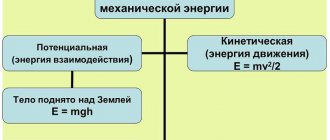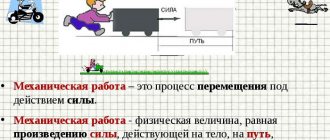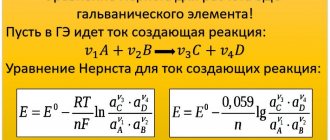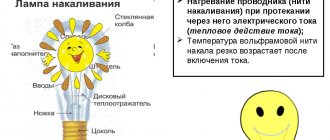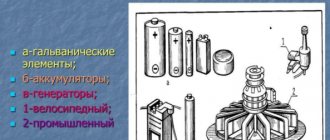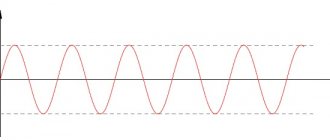4.6
Average rating: 4.6
Total ratings received: 203.
4.6
Average rating: 4.6
Total ratings received: 203.
The power of the device determines how much work it will produce and for how long, but it also determines how much energy will be consumed. Power is written on most household electrical appliances, for example, on kettles; power is also one of the characteristics of a car. But they are often measured in different units, which is why engineers have to switch between power measurement units when making calculations.
System units
Let's give a definition: in physics, power is understood as a quantity that characterizes the performance (speed of energy transfer or conversion) of mechanisms and devices. It is connected with another concept - work.
In mechanics, power is found using the formula:
$P = \frac {dA}{dt} = F \cdot v \cdot cos \alpha$, from which it follows that power is understood as work, measured in Joules, divided by the time of its execution in seconds.
Rice. 1. Work on moving cargo.
Or:
$P = \frac {dW}{dt}$, i.e. as the rate of change of energy of the system.
In electrodynamics, power has its own formula:
$P = U \cdot I$
Thus, the unit of power is Joules divided by second (Volts times Amps), or Watts. The last name was given in honor of the engineer James Watt, who created the steam engine. Watt is the SI unit of power.
In industry and on devices, larger units are often used - kilowatts, megawatts, etc. They are obtained by adding standard decimal prefixes. Accordingly, 1 kW = 1000 W, 1 MW = 1,000,000 W.
Rice. 2. Power on an electrical appliance.
In the CGS system (centimeter, gram, second), which has become widespread in electrodynamics, power is usually measured in ergs per second. $ 1 \: erg = 10^{-7} \: J $, then $ 1 \: Watt = 10^7 \: \frac {erg}{s} $
In the MKGSS system (meter, kilogram-force, second), power is measured in kilogram-force multiplied by meter and divided by s. $1 \: kgf = 10 \: N$, and then $1 \: Watt = 0.1 \: \frac {kgf \cdot m}{s}$
Electric current power measurement
The power of the electric current directly depends on the voltage and current in the circuit. Accordingly, in order to determine the current power, we need two instruments: an ammeter and a voltmeter. By multiplying the readings of these devices by each other, we obtain a numerical value of power.
There are also special devices for directly measuring power - wattmeters (Figure 1). They directly measure the power of electric current in a circuit.
Figure 1. Laboratory wattmeter
Non-system units
James Watt himself, whose name now denotes units of power, measured this parameter in horsepower. This happened historically: James compared how many horses it would take to do the same work that his steam engine did. 1 hp equal to the power that must be expended to lift a body weighing 75 kg at a speed of 1 m/s.
Now the unit of measurement that Watt used is understood as mechanical horsepower - 1 hp. = 745.7 W. But there are other types of hp. For example, in Russia they often use metric - one such hp. equal to 735.5 W. Sometimes electric (746 W), boiler (9809.5 W) and hydraulic (745.7 W) are used. They are all approximately equal, but depending on the area it is more convenient to use one or another horsepower.
In thermophysics and thermodynamics, other non-systemic units have become widespread - calories per second (cal/s). In the international standard, 1 calorie is 4.187 J. Calories, in particular, were the heat of combustion of fuel, the work required to heat water, and the energy obtained from food. From the above ratio it follows that 1 Watt is 0.24 calories.
To simplify the conversion of one unit of measurement to another, we made special tables with conversion factors. Below is one of them:
Rice. 3. Table of transition between power units.
Forms and types of energy
Since energy, as stated above, is only a measure of various forms of motion and interaction of matter, a measure of the transition of matter motion from one form to another, various forms of energy are allocated in accordance with various forms of matter motion. Thus, depending on the level of manifestation, the following forms of energy can be distinguished:
- energy of the macrocosm - gravitational or energy of attraction of bodies,
- energy of interaction of bodies - mechanical,
- energy of molecular interactions - thermal,
- energy of atomic interactions - chemical,
- radiation energy - electromagnetic,
- The energy contained in the nuclei of atoms is nuclear.
Gravitational energy is the energy of a system of bodies (particles) caused by their mutual gravitational attraction. In terrestrial conditions, this is, for example, the energy “stored” by a body raised to a certain height above the Earth’s surface - the energy of gravity. Thus, the energy stored in hydroelectric power reservoirs can be classified as gravitational energy.
Mechanical energy - manifests itself during the interaction and movement of individual bodies or particles. It includes the energy of movement or rotation of a body, the energy of deformation during bending, stretching, twisting, and compression of elastic bodies (springs). This energy is most widely used in various machines - transport and technological.
Thermal energy is the energy of disordered (chaotic) movement and interaction of molecules of substances. Thermal energy, most often obtained by burning various types of fuel, is widely used for heating and carrying out numerous technological processes (heating, melting, drying, evaporation, distillation, etc.).
Chemical energy is the energy “stored” in the atoms of substances that is released or absorbed during chemical reactions between substances. Chemical energy is either released as heat during exothermic reactions (for example, fuel combustion) or converted into electrical energy in galvanic cells and batteries. These energy sources are characterized by high efficiency (up to 98%), but low capacity.
Electromagnetic energy is the energy generated by the interaction of electric and magnetic fields. It is divided into electrical and magnetic energy. Electrical energy is the energy of electrons (electric current) moving through an electrical circuit.
Electromagnetic energy also manifests itself in the form of electromagnetic waves, that is, in the form of radiation including visible light, infrared, ultraviolet, x-rays and radio waves. Thus, one type of electromagnetic energy is radiation energy. Radiation carries energy in the form of electromagnetic wave energy. When radiation is absorbed, its energy is converted into other forms, most often heat.
Nuclear energy is energy localized in the nuclei of atoms of so-called radioactive substances. It is released during the fission of heavy nuclei (nuclear reaction) or the fusion of light nuclei (thermonuclear reaction).
The concepts of potential and kinetic energy known to us from school do not fit into this classification. Modern physics believes that the concepts of kinetic and potential energies (as well as dissipation energy) are not forms, but types of energy :
Kinetic energy is the energy that bodies possess due to their motion. More strictly, kinetic energy is the difference between the total energy of a system and its rest energy; Thus, kinetic energy is the part of the total energy due to motion. When a body is not moving, kinetic energy is zero.
Potential energy is the energy caused by the interaction of different bodies or parts of the same body. Potential energy is always determined by the position of the body relative to some source of force (force field).
Dissipation energy (that is, scattering) is the transition of part of the energy of ordered processes into the energy of disordered processes, and ultimately into heat.
The fact is that each of the above forms of energy can manifest itself in the form of potential and kinetic energy. That is, the types of energy must be interpreted in a generalized sense, because they relate to any form of motion and, therefore, to any form of energy. For example, there is kinetic electrical energy, and this is not the same as kinetic mechanical energy. This is the kinetic energy of the movement of electrons, and not the kinetic energy of the mechanical movement of a body. Likewise, electrical potential energy is not the same as mechanical potential energy. And chemical energy consists of the kinetic energy of the movement of electrons and the electrical energy of their interaction with each other and with atomic nuclei.
In general, as far as I understood when preparing this material, there is no generally accepted classification of forms and types of energy. However, perhaps we do not need to fully understand these physical concepts. It is only important to remember that energy is not some real material substance, but only a measure designed to assess the movement of certain forms of matter or the transformation of one form of matter into another.
The concept of power is inextricably linked with the concept of energy and work.
Work of force, formula
A force applied to a body and moving it does work (Fig. 1).
Rice. 1. Force moves a body and does work
The work of a force is the scalar product of the force vector and the displacement vector.
The work done by a force can be calculated using a vector or scalar form of writing the following formula:
Vector record view
\[ \large \boxed{ A = \left( \vec{F} , \vec{S} \right) }\]
To solve problems, it is convenient to write the right side of this formula in scalar form:
\[ \large \boxed{ A = \left| \vec{F} \right| \cdot \left| \vec{S} \right| \cdot cos(\alpha) }\]
\( F \left( H \right) \) – force moving the body;
\( S \left( \text{м} \right) \) – movement of the body under the influence of force;
\( \alpha \) – the angle between the force vector and the body displacement vector;
Work is denoted by the symbol \(A\) and measured in Joules. Work is a scalar quantity.
In the case where the force is constant, the formula allows you to calculate the work done by the force during the total time of its action.
If the force changes with time, then at each specific moment in time we will receive instantaneous work. These instantaneous values will differ for different points in time.
Let's consider several cases following from the formula:
- When the angle between force and displacement is acute, the work done by the force is positive;
- And if the angle is obtuse, the work is negative, since the cosine of an obtuse angle is negative;
- If the angle is right, the work is zero. A force perpendicular to the displacement does no work!
Who came up with the idea of using watts?
Current unit
A specific name was given to this unit of measurement after the name of the Scottish inventor D. Watt. It was he who first proposed the use of a standardized amount of power - horsepower. This approach became the basis for standardizing this most important parameter, the main assessment of the energy potential of power units.
Drawing of the steam engine improved by James Watt
For your information. One horsepower is equivalent to the power required to lift a 75 kg object to a height of 1 meter per second (≈734 W).
Multiple units of W
The basic value (1 W) is too small for assessing household needs. For a clear example, you can study the operation of a modern washing machine. The total power of the equipment is determined by the operating parameters:
- an electric motor that rotates the drum;
- heating element (heating element);
- pump for forced drainage of liquid;
- control and monitoring unit.
The following factors influence actual energy consumption:
- working temperature;
- duration and other features of individual modes;
- rotational speed;
- loading volume.
The information provided demonstrates the impossibility of obtaining correct results using measurements. For the convenience of buyers, energy efficiency standards have been established at the selection stage. Modern models are marked with the Latin letter “A” with the addition of “pluses”. The higher the final designation, the lower the bill for consumed electricity will be.
Using the accompanying documentation, you can clarify the parameters officially indicated by the manufacturer. An example of a modern model for energy consumption (Samsung WF60):
- class – A+++;
- for one standard operating cycle –860 W;
- per year - 175,000 W.
To simplify the assessment of such consumers, it is convenient to use the designation kilowatt - 103 (watt, kW). By applying this dimension, you can get the following result instead of the data given in the previous list:
- per cycle consumption will be 0.86 kW;
- per year - 175 kW.
From this example it is clear that the watt designation is suitable for power levels from 0.1 to 999.
In distribution and transmission networks, as well as in production processes, they operate with significantly larger quantities. The watt unit of measurement is not appropriate. To perform calculations, a multiple of 106 is used (megawatt abbreviation MW). The capital "M" is used to avoid confusion with mW. This addition, if necessary, will indicate a fraction of a watt (0.03 W = 30 mW).
Multiples and submultiples
| Decimal multiplier | Console | Designation | Example | ||
| Russian | international | Russian | international | ||
| 101 | soundboard | deca | Yes | da | dal - deciliter |
| 102 | hecto | hecto | G | h | hPa - hectopascal |
| 103 | kilo | kilo | To | k | kN - kilonewton |
| 106 | mega | mega | M | M | MPa - megapascal |
| 109 | giga | giga | G | G | GHz - gigahertz |
| 1012 | tera | tera | T | T | TV - teravolt |
| 1015 | peta | peta | P | P | Pflops - petaflops |
| 1018 | exa | exa | E | E | Em - exameter |
| 1021 | zetta | zetta | Z | Z | ZeV - zettaelectronvolt |
| 1024 | iotta | yotta | AND | Y | Ig - iottagram |
| 10−1 | deci | deci | d | d | dm - decimeter |
| 10−2 | centi | centi | With | c | cm - centimeter |
| 10−3 | Milli | milli | m | m | mA - milliampere |
| 10−6 | micro | micro | mk | µ | µF - microfarad |
| 10−9 | nano | nano | n | n | nm - nanometer |
| 10−12 | pico | pico | P | p | pF - picofarad |
| 10−15 | femto | femto | f | f | fs - femtosecond |
| 10−18 | atto | atto | A | a | ac - attosecond |
| 10−21 | zepto | zepto | h | z | zkl - zeptocoulon |
| 10−24 | iocto | yocto | And | y | ig - yoctogram |
So, to display units or multiples of units for resistance, current or voltage, we would use as an example:
- 1 kV = 1 kilovolt - which is equal to 1000 volts.
- 1 mA = 1 milliamp, which is equal to one thousandth (1/1000) of an ampere.
- 47 kOhm = 47 kiloohms - which is equal to 47000 Ohms.
- 100uF = 100 microfarads, which is equal to 100 millionths (100/1,000,000) of a farad.
- 1 kW = 1 kilowatt, which is equal to 1000 W.
- 1MHz = 1 megahertz, which is equal to a million Hertz.
To convert from one prefix to another you must either multiply or divide by the difference between the two values. For example, in order to convert MHz to kHz, you need to multiply the value in kHz by 1000, i.e. 1MHz = 1000kHz.
Power determination
The speed of work is characterized by a physical quantity called power.
Power is a physical quantity equal to the ratio of work to the time during which it was performed.
To calculate power, you need to divide the work by the time during which this work was done:
$$power = \frac{work}{time}$$
or
$$N = \frac{A}{t}$$
where $N$ is power, $A$ is work, $t$ is the time it takes to complete the work.
Power can be:
- Constant if the same work is done every second
- Non-constant if different work is done every second. In this case, we talk about average power: $N_{avg} = \frac{A}{t}$
Sub-unit W
Having found out what is measured in watts, you can move on to the nuances that are important for practice. In some situations, the base units are too large to estimate performance parameters. Thus, some sensors (heat, light) consume a minimum of electricity. The power of a suitable power supply can be determined after performing the calculation. For convenience, instead of 1 watt, fractional values are used:
- 10-3 – mW, milliwatt;
- 10-6 – µW, microwatt;
- 10-9 – nvt, nanowatt.
Zeptowatts (10-21) and other smallest units have no practical significance in everyday life. These values are used in theoretical calculations of various physical processes.
Formula for the relationship between power, voltage and current
To derive dependencies between the parameters under consideration, you can return to the definition with work. In this case, the movement of charge (Q) over a given distance is considered. When moving from point F1 to F2, work (A) will be performed equal to the change in potential or voltage. The basic formula is easy to transform:
P=A/t = (U/t)*Q.
The current strength is determined by the amount of charge that moves during the control time (I = Q/t). After combining the marked dependencies, the following result will be obtained:
P = U * I.
“Related” parameters have been removed from this expression. Typical electrical quantities are left. If we add the well-known formula of Ohm's law, we can establish working relationships for calculations taking into account electrical resistance:
P = U2/ R = I2 * R.
Basic formulas for calculation
For your information. The presented dependencies allow you to obtain accurate calculation results when working with a direct current source. However, in a standard household network, single-phase 220 V power is used. The signal amplitude changes with a normalized frequency of 50 Hz, so it is necessary to take into account the peculiarities of energy consumption by different types of loads.
If a classic incandescent lamp or a boiler with a heating element is connected to heat water, it is permissible to use the formulas discussed above. However, the simple technology is not suitable when dealing with load reactance. Inductive and capacitive components form an oscillating circuit. The process of accumulation and exchange of energy with the power source is activated. During such cycles, part of the power is wasted, so for an accurate assessment the active component is isolated:
Pact = U * I * cos ϕ.
The additional multiplier in the formula characterizes the losses in a certain load. The cos ϕ value is indicated on the nameplates of electric motors, in the accompanying documentation for machines, transformers, and generators.
Experts advise not to forget about “useless” reactive power (Preact = U * I * sin ϕ). The passage of current through a circuit in any direction increases the energy potential of the molecular lattice of the conductor. This process is accompanied by heating. If you exclude this component from the calculations, the risk of breakdowns and emergency situations increases. The total power watt can be calculated using the formula:
Ptotal = √((Pact)2 + (Preact)2).
Special equipment is used to check operating circuits, repair and configure. You can measure power with a wattmeter. For constant online monitoring, such a unit can be installed in the electrical panel. Products in this category are equipped with indications. Some models are capable of transmitting information over a local network and via the Internet.
In the mobile version, the wattmeter is used to clarify the electricity consumption of devices connected to the outlet
Instead of specialized equipment, you can use a standard universal multimeter. To measure current, the device is connected to an electrical circuit in series with the load. Parallel connection will help you find out the voltage. Next, using the formulas presented above, calculate how much power watts a TV or other equipment consumes.
Power formula
Illuminance unit
By basic definition, from the horsepower example discussed above, the principle of calculating energy consumption is clear. Power ( P ) can be measured in terms of work (A) done in a certain time interval ( t ) as follows:
P=A/t.
Inverse proportionality emphasizes the relative increase in energy expenditure to quickly perform a specific action.
F applied to the object and the speed of movement ( V ):
P = F * V.
The direct dependence of power on the two components from the second part of the formula is clear without detailed explanation. If the speed is expressed in terms of the distance traveled (D) in a certain time (V = D/t), after a simple mathematical transformation we can obtain the following result:
P = (F * D)/t.

